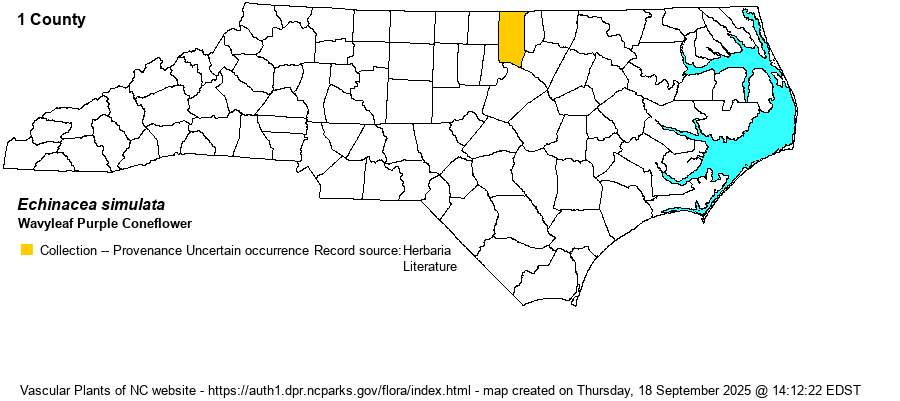| Author | R.L. McGregor | |
| Distribution | The only specimens at SERNEC are from a roadside near Butner in Granville County. This population has formerly been considered for several decades as E. pallida, but Weakley (2024) now states that the specimens in the eastern Piedmont for E. pallida are likely to be E. simulata (see below).
Native to "IN, IL, and MO south to KY, TN, and n. AR" (Weakley 2018); "some of the more eastern disjunct populations previously considered to be E. pallida are actually E. simulata; additional work is needed to disentangle the relative distributions of these two species in our area" (Weakley 2018). | |
| Abundance | Extremely rare. Presumed not native, based on the far disjunction from the range west of the Appalachians, and the roadbank habitat near Butner. The species is not in the NC NHP database and thus the editors suggest a State Rank of SE?. | |
| Habitat | This is a prairie species in its native range, also in open glade-like woodlands. | |
| Phenology | Blooms and fruits June-July. | |
| Identification | This purple coneflower is extremely like E. pallida except that it has pale to bright yellow pollen, versus white (to rarely lemon yellow) pollen in E. pallida. The ray blades are 4-7 mm wide, versus just 3-4 mm wide in E. pallida (Weakley 2018). The leaves of these two species are noticeably narrower than are those of the other two species in the state -- E. laevigata and E. purpurea. | |
| Taxonomic Comments | See Distribution comments. Some specimens in the Southeastern states formerly considered as E. pallida have recently been determined to be E. simulata.
| |
| Other Common Name(s) | Prairie Purple Coneflower | |
| State Rank | SE? | |
| Global Rank | G4 | |
| State Status | | |
| US Status | | |
| USACE-agcp | | |
| USACE-emp | | |

